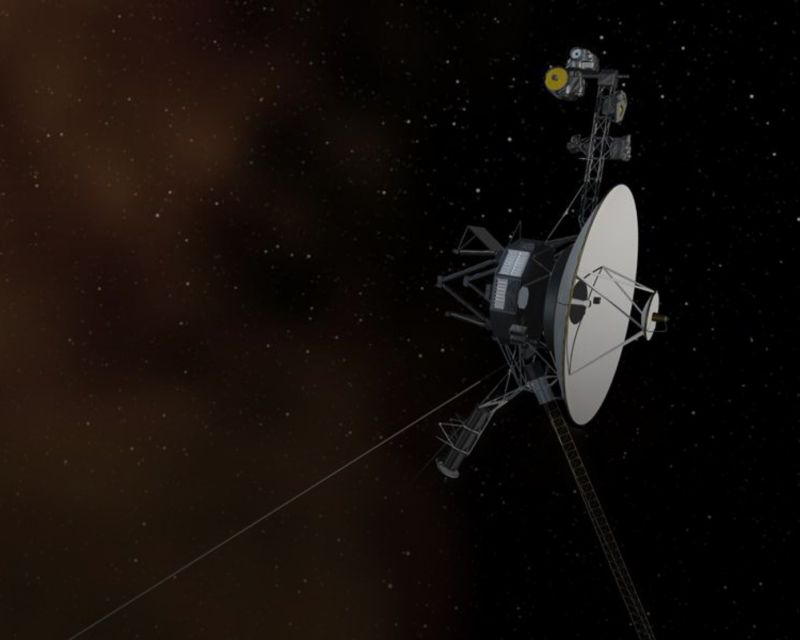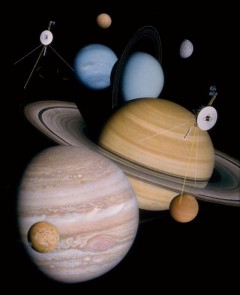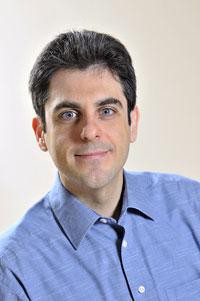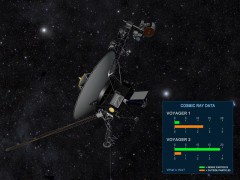
“The heavenly motions…
are nothing but a continuous song for several voices,
perceived not by the ear but by the intellect,
a figured music which sets landmarks
in the immeasurable flow of time.”
— Johannes Kepler (1571-1630)
From the Pythagoreans in Ancient Greece to Nicolaus Copernicus and Johannes Kepler in 16th century Europe, scientists and philosophers have long sought to understand the celestial harmony and mathematical ratios of Musica universalis, the Music of the Spheres, a concept believed to be an inherent property of the Cosmos.
Today, the Music of the Spheres has long disappeared from our conversations about space, but one physicist is trying to bring it back—by creating music out of celestial motions. To help, he’s signed up two intrepid spacecraft that are on their way out of the Solar System: Voyagers 1 and 2.

The twin probes were part of NASA’s Voyager program of the 1970s, with the goal of exploring the planets of the outer Solar System for the first time. Taking advantage of a rare planetary alignment which occurs every 176 years, the Voyagers embarked on an epic planetary “Grand Tour” that provided us with our first-ever views of Jupiter, Saturn, Uranus, Neptune, and their many dozens of moons.
Almost 37 years after they were launched, the Voyagers are on their way to the stars, with Voyager 1 already having crossed to interstellar space. Along the way, their magnetometers have meticulously gathered data from the cosmic rays that permeate space. Those readings were taken by Domenico Vicinanza, an accomplished professional musician and physicist, and transformed into beautiful small orchestral symphonies—a literal Music of the Spheres.
Vicinanza is an Italian music composer with a PhD in physics from the University of Salerno in Italy. As well as working as a music professor and Technical Coordinator on Algorithmic Composition for the ASTRA Project and a network engineer for the development of pan-European research networks at DANTE, his impressive résumé also includes a stint as a Scientific Associate and Project Associate at the Large Hadron Collider at CERN in Geneva.
Enchanted by the wonderful blending of science and music in Vicinanza’s work, I had the pleasure of chatting with him via e-mail, and I asked him a few questions about his latest musical project. His work is also a reminder of the fact that space exploration can always uplift and inspire, while also helping to enhance our quality of life here on Earth in ways not previously imagined.
Dr. Vicinanza, first of all I’d like to thank you for taking some time out of your schedule to answer a few questions for our readers. Would you like to share with us some more info about your academic background and what inspired you into science and music?
It is me who thanks you. I work supporting universities and research centres in Europe bridging science and art, organising artistic performances using networks—like distributed dance events, for example.
I am also a music composer, and I have a PhD in particle physics. I’ve always loved both music and science, and I found it fascinating both to approach music with a scientific mind and science from a musician’s perspective. The relationship lies in a common quest for harmony. Harmony is a term used in science and music with more or less the same meaning.
My artistic and research work has been heavily influenced by the possibilities offered by combining science, music, and art.

At first glance, when one thinks of inspiration for a musical composition, the Voyagers’ magnetometer measurements are not the first thing that comes to mind. How did you come up with the idea of converting these data into music and how exactly was this accomplished?
Yes, that’s true, a music piece and a magnetometer are typically two quite distant entities. But I love music and I’ve always loved astronomy and space research. In particular, I love the Voyager mission: it’s one of the greatest and most successful scientific endeavours in history. It was a wonderful opportunity to join my two passions.
In terms of the actual process, sonification works by attaching a musical note to each measurement taken from the spacecraft. So, when you hear the resulting melody you really are hearing the data. Intervals between values in the original data set are mapped to intervals between notes in the melody. The same numerical value was associated with the same note. As the values increased or decreased, the pitch of the notes grew or diminished accordingly.
In this way any regularity in the scientific data can be naturally mapped to the melody: if the data are periodic (they are marked by a repeated cycle) the sonification will be a musical melody which will have the same periodicity and regularity.
The Voyagers have been taking measurements of cosmic rays in space for more than 35 years. How easy a task was it to dig through this immense volume of data?
It was a fascinating journey. It was great getting data from the late seventies, reading measurements taken billions of kilometres from here. The whole history of the spacecraft, their encounter with Saturn, Jupiter, the outer planets, and theirs satellites, the exit of Solar System were written there.
You have also led a similar music project in the past, where you took the data from the Large Hadron Collider that led to the discovery of the Higgs boson in 2012 and converted them into music as well. Can you tell us a bit more about this project, and how it is related, if at all, to the Voyager one?
Yes, in the past I worked with different data sources and in different fields, from hydrobiology to volcanoes, from spacecraft to NASDAQ, from baseball scores to DNA. I worked on an artistic commission for the City Dance Ensemble in Washington D.C., writing a musical piece using four volcanoes’ seismographs.
Again in 2012, I was invited by the Auditorium Parco della Musica in Rome to write music for an entire concert based on sonified data. In that occasion, I created music starting from different sources, for example converting the position of the stars in the constellations into music, or the list of the European countries.

The Higgs boson piece was mainly written as a celebratory piece, the sonification is an alternative representation of the scientific graph the ATLAS experiment presented on 4 July 2012. It offers the same qualitative and quantitative information contained in the graph, only translated into notes.
In more general terms, thinking about data sonification and its potential I can surely say that listening to melodies from sonification could be useful for many reasons. For example, it would allow a blind researcher to understand exactly where a peak is in a graph, for example. Or the shape of a data distribution, or how relevant a certain anomaly is. At the same time, it could give a musician the opportunity to explore the fascinating world of high-energy physics by playing its wonders.
By studying different sonification algorithms we can find more and more effective ways to allow researchers to detect interesting phenomena by listening to them. Since sound is not directional—i.e. one does need to stare a monitor or stay exactly in front of a screen—sonification can be used on the move, while shopping or travelling.
The biggest challenge is choosing the right mapping between data and sound, the right algorithm that associates data and notes.
What are your plans for the future? Are you thinking of taking this idea of music conversion and applying it to other areas as well?
Yes, definitely. I am continuing with Voyager, trying to explore with sound and music how Voyager 1 and 2 music is evolving (now that Voyager 1 has left the solar system). I have a piano trio suite based on Voyager 1 and 2 data, and I am also working on solar data and planning an interactive display where the audience can create work of arts using data recorded since 1749!
Dr. Vicinanza, before we close, I’d like to thank you for your insight regarding your fascinating work.
You’re welcome. I was happy to help!
Dr. Vicinanza’s music, including the Voyager 1 and 2 duet, is available to listen to online on the Soundcloud website here.
The article originally appeared on the Looking Up website. Republished here with kind permission.
Want to keep up-to-date with all things space? Be sure to “Like” AmericaSpace on Facebook and follow us on Twitter: @AmericaSpace



